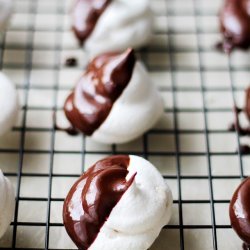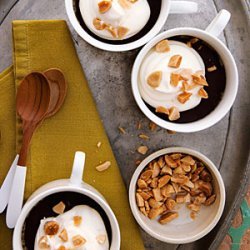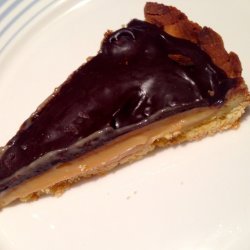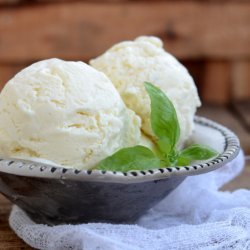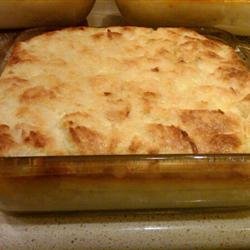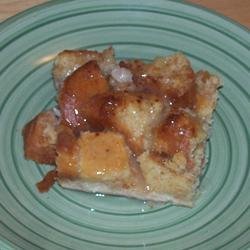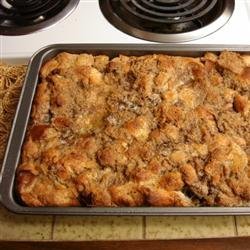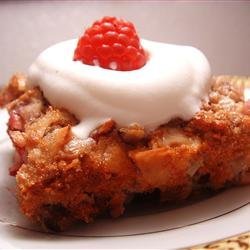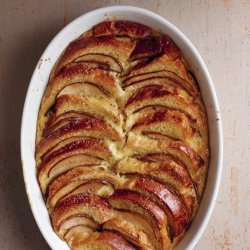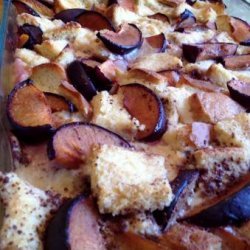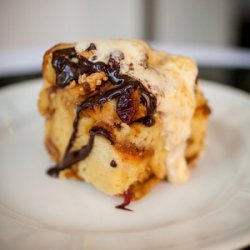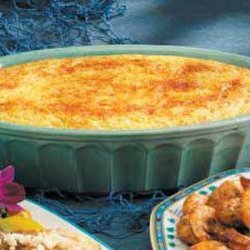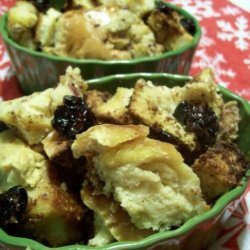Directions:
- Preheat the oven to 315 degrees F.
- For the custard: Pour the milk and half of the sugar into a non-reactive, 2-quart heavy-bottomed saucepan. While the milk is heating over medium-high heat, use a sharp paring knife to slice the vanilla bean in half lengthwise. Separate the seeds from the outside skin by scraping the bean with the knife. Place the skin and seeds in the heating milk. Scald the milk mixture by heating it until bubbles start to form around the edge of the pan. Remove from heat.
- Place the remaining sugar, the whole eggs, and egg yolks in a large mixing bowl and whisk until well incorporated. When you add sugar to eggs (especially to egg yolks), it is important to create an emulsion quickly or else a chemical reaction that produces heat will occur. If you do not whisk immediately, this heat will cook the egg yolks and cause lumps in the custard. Continue to whisk while slowly pouring the hot milk into the egg mixture and whisking until the mixture is smooth and homogenous in color. Try not to create air bubbles on the surface of the custard when you whisk, as these can form a crust on the baked custard. Pour the mixture through a fine-mesh sieve to remove the vanilla bean pieces and any overcooked eggs. If you are using raisins, evenly distribute them on the bottom of each mold. Slice the brioche into 3/4-inch-thick slices and remove the crust. Dice each slice into 1/2-inch cubes. Fill 6 (8-ounce) molds about half-full with the brioche cubes. Fill the molds half-full with the custard and set them in a roasting pan in the oven (it is much easier to transfer the pan with the molds only half-full). Fill the molds to the top with the custard. It is important to fill the molds completely since the custard loses volume as it bakes.
- Traditionally, custard is baked in a hot water bath to insulate it from the direct heat of the oven and to keep the eggs from cooking too fast, which would cause them to separate. Use hot water from the tap and pour enough water into the roasting pan to reach halfway up the sides of the molds. When baked correctly, the custard should tremble slightly when gently shaken. In a conventional oven, this should take about 1 hour 15 minutes for a large mold, 45 minutes for individual molds. If you detect any liquid under the skin, the custard is under baked. Put it back in the oven and shake it every 5 minutes until it is ready. If the custard begins to bubble during baking, reduce the oven temperature by 25 degrees F (14 degrees C).
- Remove the mold from the oven and the water bath and place on a wire rack for 30 minutes. Refrigerate for 2 hours before serving; it will finish setting in the refrigerator. Let the water bath cool before removing it from the oven.
- To unmold: Carefully run a sharp paring knife around the inside of each mold to loosen the custard. Invert a flat plate over the bread pudding. Place 1 hand on either side, grasping both plate and mold, and flip them both so that the mold is on top. Gently lift off the mold. You may need to tap the bottom of the mold to release the custard.
- Sometimes I like to decorate the plate by alternating drops of Creme Anglaise sauce and raspberry sauce around the bread pudding. Then I swirl the sauces together with the tip of a paring knife.
- Jacques' tip: If you wanted to make this in a single large mold or baking dish, follow the exact same directions using an 8-cup mold or baking dish. A large bread pudding will need to bake for about 60 minutes. Use the same test for doneness.
Nutrition Facts
| Amount Per 1 Serving | |||
| Calories | 303.7 Kcal (1272 kJ) | ||
| Calories from fat | 75 Kcal | ||
| % Daily Value* | |||
| Total Fat | 8.33g | 13% | |
|---|---|---|---|
| Cholesterol | 313.27mg | 104% | |
| Sodium | 187.27mg | 8% | |
| Potassium | 370.47mg | 8% | |
| Total Carbs | 42.33g | 14% | |
| Sugars | 41.5g | 166% | |
| Protein | 15.73g | 31% | |
| Iron | 1.7mg | 9% | |
| Calcium | 246.3mg | 25% | |
| Amount Per 100 g | |||
| Calories | 108.46 Kcal (454 kJ) | ||
| Calories from fat | 26.79 Kcal | ||
| % Daily Value* | |||
| Total Fat | 2.98g | 13% | |
|---|---|---|---|
| Cholesterol | 111.88mg | 104% | |
| Sodium | 66.88mg | 8% | |
| Potassium | 132.31mg | 8% | |
| Total Carbs | 15.12g | 14% | |
| Sugars | 14.82g | 166% | |
| Protein | 5.62g | 31% | |
| Iron | 0.6mg | 9% | |
| Calcium | 88mg | 25% | |
* Percent Daily Values are based on a 2000 calorie diet. Your daily values may be higher or lower depending on your calorie needs.
Find out how many calories should you eat.
Get Your Recipe of Health!
Follow RecipeOfHealth on Facebook!


